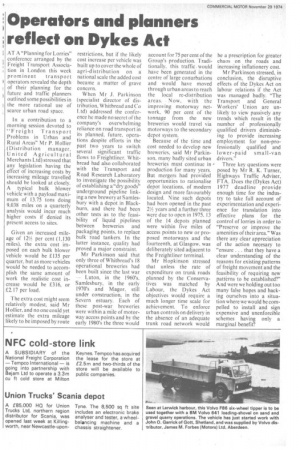Operators and planners reflect on Dykes Act
Page 18

If you've noticed an error in this article please click here to report it so we can fix it.
AT A "Planning for Lorries" conference arranged by the Freight Transport Association in London this week prominent transport operators revealed the depth of their planning for the future and traffic planners outlined some possibilities in the more rational use of scarce urban road space.
In a contribution to a morning session devoted to "Freight Transport Problems in Urban and Rural Areas" Mr P. H oilier (Distribution manager, United Agricultural Merchants Ltd) stressed that any legislation having the effect of increasing costs by increasing mileage travelled should he looked at closely. A typical bulk blower vehicle with a payload maximum of 13.75 tons doing 9,038 miles on a quarterly analysis would incur much higher costs if denied its present access to sites.
Given an increased mileage of l2¼ per cent (1,130 miles), the extra cost imposed on each bulk blower vehicle would be £135 per quarter, but as more vehicles would be needed to accomplish the same amount of work the realistic cost increase would be £316, or £2.17 per load.
The extra cost might seem relatively modest, said Mr H oilier, and no one could yet estimate the extra mileage likely to be imposed by route restrictions, but if the likely cost increase per vehicle was built up to cover the whole of agri-distribution on a national scale the added cost became a matter of grave concern.
When Mr J. Parkinson (specialist director of distribution, Whitbread and Co Ltd) addressed the conference he made no secret of the company's overwhelming reliance on road transport in its planned, future, operations despite efforts in the past two years to switch several significant traffic flows to Freightliner. Whitbread had also collaborated with the Transport and Road Research Laboratory to investigate the possibility of establishing a"dry goods" underground pipeline linking a new brewery at Samlesbury with a depot in Blackburn, and there had been other tests as to the feasibility of liquid pipelines between breweries and packaging points, to replace bulk road tankers. In the latter instance, quality had proved a major constraint.
Mr Parkinson said that only three of Whitbread's 18 operational breweries had been built since the last war — Luton, in the 1960's. Samlesbury, in the early 1970's and Magor, still under construction, in the Severn estuary. Each of these post-war breweries were within a mile of motorway access points and by the early 1980's the three would account for 75 per cent of the Group's production. Traditionally, this traffic . would have been generated in the centre of large conurbations and would have moved through urban areas to reach the local re-distribution areas. Now, with the improving motorway network, 90 per cent of the tonnage from the new breweries would travel via motorways to the secondary depot system.
Because of the time and cost needed to develop new breweries, said Mr Parkinson, many badly sited urban breweries must continue in production for many years. But mergers had provided opportunities to rationalise depot locations, of modern design and more favourably located. Nine such depots had been opened in the past 21/2 years and a further three were due to open in 1975, 13 of the 14 depots planned were within five miles of access points to new or proposed motorways and the fourteenth, at Glasgow, was deliberately sited adjacent to the Freightliner terminal.
Mr Hopkinson stressed that unless the rate of expenditure on trunk roads planned by the Conservatives was matched by Labour, the Dykes Act objectives would require a much longer time scale for achievement. To enforce urban controls on delivery in the absence of an adequate trunk road network would be a prescription for greater chaos on the roads and increasing inflationery cost.
Mr Parkinson stressed, in conclusion, the disruptive effects of the Dykes Act on labour relations if the Act was managed badly. "The Transport and General Workers' Union are unlikely to view passively any trends which result in the number of professionally qualified drivers diminishing to provide increasing employment for non-professionally qualified and lower-paid small-van drivers."
Three key questions were posed by Mr R. K. Turner, Highways Traffic Adviser, FTA. Does the (Dykes Act) 1977 deadline provide enough time for the industry to take full account of experimentation and experience for translation into effective plans for the control of lorries in order to "Preserve or improve the amenities of their area," Was there any clear appreciation of the action necesary to "ensure . . . that they have a clear understanding of the reasons for existing patterns of freight movement and the feasibility of requiring new patterns to be established?" And were we holding out too many false hopes and backing ourselves into a situation where we would be compelled to install and sign expensive and unenforcible schemes having only a marginal benefit?




























































































